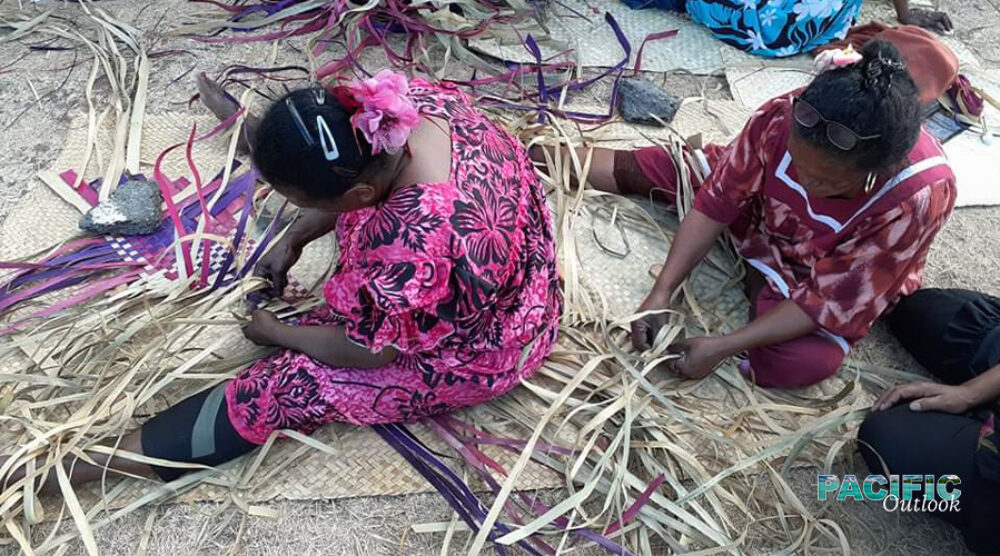ROSS WESTOBY, RACHEL CLISSOLD, KAREN McNAMARA AND VIVIANE OBED
Before COVID-19, tourism in Vanuatu accounted for 34.7 per cent of the country’s national GDP and employed 36 per cent of the population directly or indirectly. While borders are now open again, tourism numbers will take time to reach pre-pandemic levels, with airlines struggling to meet demands and two cyclones hitting many Vanuatu islands at the beginning of 2023.

In this study, we examine the lived experiences, including responses, of women handicraft vendors in Vanuatu who have, in recent years, endured various disasters (hazards impacted by human vulnerability). We aimed to understand how disasters affect ‘invisible’ members of the informal sector (i.e., the section of any economy that is neither taxed nor monitored by the government, despite being a viable form of employment, especially in developing and transition economies) whose livelihoods depend on the fringes of tourism.
Thirteen unstructured interviews with ni-Vanuatu women (i.e., women from Vanuatu) informal handicraft vendors in Vanuatu, with lived experiences in an intersecting hazard world, were the study’s focal point. Two sets of data were collected for this study: (1) one group interview (with three participants) conducted in December 2018 (pre-pandemic) and (2) a series of unstructured/conversational interviews (n=12 with 13 participants) undertaken by one of the authors (a local ni-Vanuatu researcher) between January and May 2021.
Vendors shared that their experiences were influenced by and exist within an inequitable and gendered system that creates specific, intersecting gendered barriers, burdens, expectations, and pressures that hinder their capacities to recover and adapt. One of the critical barriers several women experienced was the lack of recognition of their voice and needs:
“Vanuatu is indeed a male-dominated country. Therefore, it is a bit hard; they will not take you seriously.”
(participant #11, 2021)
Working in the informal sector as a woman means ‘voice’ and ‘representation’ are sidelined from the various tiers of government:
“When the government wants to respond to our needs, people think it is not important, and they forget about us.”
(participant #2, 2021)
A ‘stimulus package’ from the national government that provided financial support was poorly distributed, and few handicraft vendors received it. Likewise, infrastructure reconstruction was not prioritised following the Cyclone Pam. Reflecting, two participants lamented:
“We did not receive any help from our leaders… None of us got any help from the village, government, or any association.”
(participant #4, 2021)
“Some of us are asking the MPs and councillors to help us, but they have not.”
(participant #6, 2021)

Women are not passive victims. Evidence of vendors’ strategies to cope and respond to hazards at the individual/ household and collective scales show their active engagement. The women handicraft vendors at the individual and household level demonstrate critical capacities to diversify livelihoods (e.g., selling flowers and local food) and utilise existing resources to cope (e.g., turning to traditional subsistence lifestyles and gardens to save money on food). Such strategies help address financial insecurities and burdens the lack of tourists imposes.
We found that heavy workloads and emotional burdens mean women bear the costs of adjusting to multiple shocks and pressures, acquiring the responsibility of finding additional income while maintaining traditional gendered responsibilities in the home and community. Heavy workloads can be a significant barrier to the capacity to grow small and micro enterprises (i.e., by lacking time and production remaining slow), to cope and respond to shocks effectively and recover businesses, but also for women’s empowerment, agency, and wellbeing. Women are overwhelmingly represented in the micro-enterprise space, especially in the tourism sphere, and this obscures their lack of empowerment in other spheres.
Outside the formal sector, financial pooling and risk-sharing, livelihood diversification training programmes, activism, community labour, and turning to traditional subsistence lifestyles are creative means of resilience-building. Support and resources (such as training and capital), for existing groups and their collective action efforts, could be an intervention that drives women to cope and meet immediate needs (e.g., grassroots financial risk-sharing and fundraising) while also supporting them in more transformational ways (e.g., through training and upskilling programmes and providing a platform from which to lobby needs and rights).
Future studies should build on and further unpack the engagement of handicraft women vendors with the various local institutions they value and identify the key barriers, challenges, strengths, and opportunities for social support.
Dr Ross Westoby is a Research Fellow at the Griffith Institute for Tourism. His research interests include the intersectionality between society and the environment, with particular interest in climate loss and adaptation across the South Pacific and in Australia.
Ms Rachel Clissold is a Senior Research Assistant in the School of Earth and Environmental Science at The University of Queensland and a consultant at the International Centre for Environmental Management, Hanoi, Vietnam. Her research interests include climate change adaptation, gender, and development more generally.
Dr Karen E McNamara is a Professor in human geography at the School of Earth and Environmental Sciences at The University of Queensland. Her research interests include resilient livelihoods, climate change adaptation, non-economic loss and recovery, human mobility, and gender. Ms Viviane Obed is a gender and development lead who heads up Further Arts and Ni-Vanuatu NGO based in Port Vila that supports indigenous languages and culture.
The views expressed in this article are those of the author(s) and do not necessarily represent the position of the above-mentioned institution(s).








